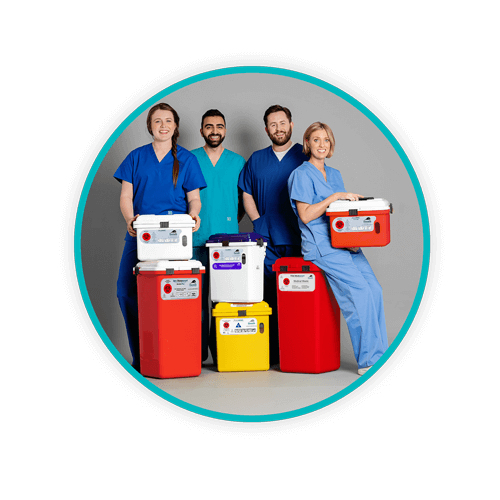Biomedical Waste Segregation Guidelines

Before getting into the specifics of biomedical waste management and segregation, it’s important to standardize the definition of biomedical waste. Often also known as infectious waste or biohazard waste, following biomedical waste segregation processes are essential, not only in protecting healthcare workers, but the public and the environment.
TOPICS WE WILL COVER:
1 / Biomedical Waste Definition
2 / Segregating Biomedical Waste
3 / State Regulate Guidelines for Training
Biomedical Waste Definition
Biological waste is defined as any type of material that has been or might be contaminated by a biohazardous or infectious agent. Biological waste is not limited to blood or blood-soaked materials, but can also include:
- Syringes
- Surgical wrappings
- Culture tubes
- Petri dishes
In addition to contaminated blood or blood products mentioned in the above list, a biohazardous agent can also include parasites, viruses, bacteria, and fungi. Daniels Health encourages processes that follow proper and compliant medical waste management –that includes identification, segregation, and proper disposal of all medical waste generated by a healthcare facility.
A number of resources are available online such as those found at the Healthcare Environmental Resource Center, which provides its own definition of biomedical waste:
“blood and blood products, exudates, secretions, suctionings, and other body fluids, which contains free liquids and cannot be or are not directly discarded into a municipal sewer system.”
Based on federal regulations, biomedical waste segregation guidelines require that it be segregated into appropriate containers from other waste at the point of origin. Such containers should be resistant to moisture and have enough structure to reduce the risk of tearing, bursting, or damage under normal conditions. Such containers should also be securely closed to prevent leaking, dripping, or other exposure during storage, handling, as well as transportation.
In order to segregate biomedical waste properly, employees must be trained in its identification. State governments (on top of federal regulations) provide specific waste segregation guidelines. For example, in the state of Colorado, it is the responsibility of the waste generator to determine or identify waste as “regular” medical waste, hazardous waste, ordinary solid waste, or radioactive waste. It is then segregated appropriately. All healthcare providers should be aware of federal, state as well as local statutes, policies, and regulations, and guidelines provided by the facility itself.
Colorado’s guidelines state that medical waste includes any waste that is generated in a healthcare setting that is generated in the diagnosis, treatment, immunization or care of humans or animals. Such waste can be produced by autopsies, by a funeral home preparing the body for cremation, or in research settings. The state of Colorado provides a flowchart for medical waste identification and detailed state codes, guidelines and regulations regarding its disposal.
In regard to hazardous waste in Colorado, healthcare providers should refer to 6 CCR 1007-3. Colorado does not have any solid waste landfills that are currently approved to accept hazardous waste, emphasizing the importance for proper biomedical waste segregation for compliance.
In Florida, requirements for storage, containment, labeling and treatment of biomedical waste as well as its transport are found under state codes: Chapter 64E-16. In the state of Florida, biomedical waste is defined as
“any solid or liquid waste which may present a threat of infection to humans, including non-liquid tissue, body parts, blood, blood products, and body fluids from humans and other primates; laboratory and veterinary wastes which contain human disease causing agents;, and discarded sharps…” among others.
In Florida, biomedical waste that has been mixed with some type of hazardous waste must be managed as hazardous waste. Storage of biohazardous waste should not exceed 30 days from the time the first item of that waste is placed into a sharps container or red bag.
Keep in mind that every state will specify their own regulations regarding biomedical waste segregation. So, how exactly do you segregate biomedical waste?
Segregating Biomedical Waste
Proper and compliant biomedical waste segregation relies on accurate identification of waste streams, regardless of the type of facility (dental, hospital, outpatient center, veterinary services, and so forth). Proper identification of waste streams helps to minimize waste as well as prevent certain types of waste from ending up in landfills. Primary categories of waste streams include:
- Regulated medical waste
- Sharps waste
- Pharmaceutical waste
- Chemotherapy waste
- Hazardous waste
- Pathological waste
Terminology may differ between states, emphasizing the importance of training for every employee working in a facility that produces medical waste of any kind. Proper and compliant biomedical waste segregation relies on specific containment systems designed for each type of waste stream.
A number of container options are available to healthcare facilities with different dimensions and fill capacity. Waste stream containers are also color-coded. For example, sharps that including blades, needles, ampoules, or anything sharp that may pierce or slash the skin is relegated to a red sharps container. Red is also a general “biohazard” color for infectious and biomedical waste products. Trace chemotherapy waste is generally placed into yellow containers.
Traditional regulated medical waste and pharmaceutical containers can be single use or reusable, and also come in a variety of sizes. Placement guidelines are typically found under federal or state regulations, and/or regulations of the healthcare facility using them.
States Regulate Guidelines for Training
Every state has their own regulations and guidelines for training healthcare employees on proper segregation and handling. For example, in the state of Florida, regulations for biomedical waste management include:
- Training and understanding of the segregation process, labeling, handling and storage as well as transportation and treatment of waste;
- Maintenance of initial and annual training records by facilities, which must be kept for at least three years;
- A site-specific biomedical waste plan;
- Permits to generate, store, treat and transport biomedical waste;
- State inspections;
- Enforcement (lack of compliance may result in suspended or revoked permits and fines of up to $2500 a day per violation)
In Texas, biohazard waste management regulations are overseen by the Texas Natural Resource Conservation Commission. In Arkansas, biomedical waste regulations are managed by the Arkansas Department of Health, and in Ohio by the Ohio EPA’s Infectious Waste Program.
Because of slight differences in terminology and regulations (many states have more rigorous and stringent regulations than federal guidelines), it is vital that employees are aware of their state’s waste stream segregation guidelines. Such guidelines are not a “one size fits all”.
Daniels Health Supports Proper Waste Segregation
Daniels Health provides a number of products, services, and resources for every state when it comes to biomedical waste management, waste stream segregation, and storage and disposal of different waste streams. We encourage a cradle-to-grave approach that not only reduces the risk of non-compliance, but also enhances the safety of healthcare employees, the general public, and our environment. For more information about Daniels Health, our products, services, or resources, contact us today.
Let's Talk!
Your time is valuable, and we don’t want to play hard to get. You can either phone us directly on the details listed on our contact page, or feel free to fill out this short form and one of our team members will get back to you as quickly as possible.

